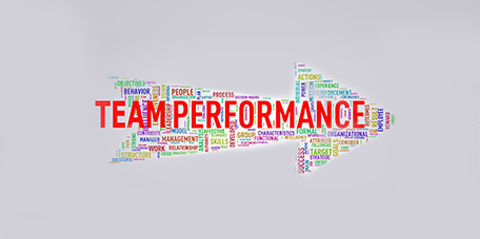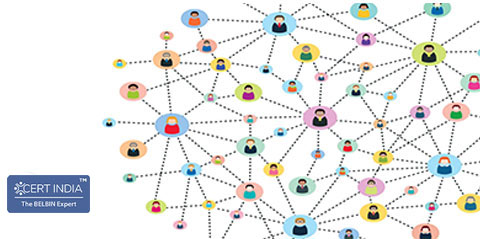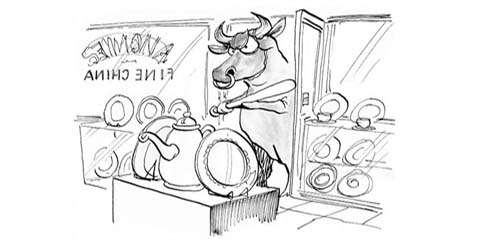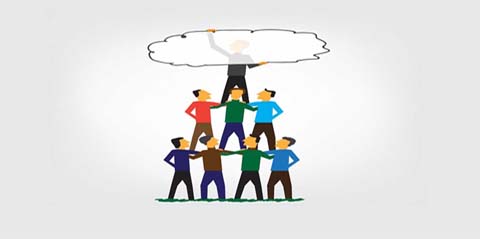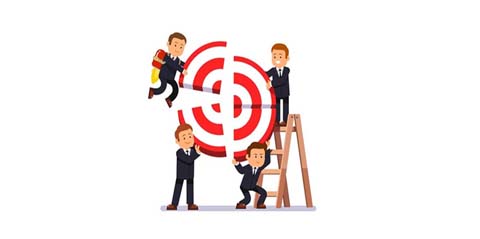“When all think alike, then no one is thinking.”*
Groupthink occurs when a group’s pursuit of cohesion and conformity limits creativity and diversity, disrupts the group’s ability to solve problems and make decisions, and overpowers the morality of individuals within the group. The situation – rather than individual character traits – becomes the main driver for behaviour, with potentially dangerous consequences.
The term 'Groupthink' was first defined by psychologist, Irving Janis, in 1972 as:
“a mode of thinking people engage in when they are deeply involved in a cohesive in-group, when the members' striving for unanimity override their motivation to realistically appraise alternative courses of action. Groupthink refers to a deterioration of mental efficiency, reality testing, and moral judgment that results from in-group pressures”.1
*Walter Lippman
The problem is, groupthink is insidious, and it can come from an apparently positive place.
Groupthink comes from cohesion. It’s what happens when we share interests, ideas and goals and it’s often the focus of organizational efforts seeking harmony within groups or departments. But too much of it can lead to a prescriptive group culture which prizes unanimity over diversity.
Groupthink comes from the tendency to spot patterns and the impetus to replicate success. Cloning in recruitment (leading towards homogeneity in an organisation) is a common example.
Groupthink comes from a desire to please. Our obedience to authority is ingrained from childhood and education, and most of us are primed to work with authority if we recognise it as legitimate. Our desire to please the boss is an understandable driver of behaviour which naturally follows on from this instinct.
There are other factors that can make groups more predisposed to groupthink, too.
If the group is insular and isolated, it makes it easier to maintain the status quo and reject outside views. The group fails to consult experts and if expert advice is offered, the group suffers from selective bias when processing that information. Nonconformists are brought into line. People stop asking questions and this gives the illusion that everyone is in agreement. An ‘us and them’ mentality prevails, which stereotypes and denigrates the ‘opposition’.
If a leader is intimidating and pushes for performance at any cost whilst turning a blind eye to the methods, ‘the end justifies the means’ becomes a phrase to live by.
If there are no protocols in place to offer checks and balances when making decisions, people begin to feel invincible and take excessive risks in the name of success. Brook Larmer, a journalist for the New York Times, described a ‘spell of impunity' in the banking industry prior to the crash, which led certain groups to take reprehensible actions, considering themselves above the law and ignoring their own moral compass in pursuit of their goals.2
So, what’s the tipping-point? When does a team become a group? How does the psychology change, and what influence does this have on individual behaviours? How do we guard against ‘groupthink’ when the drive towards uniformity is ingrained in us?
Team and Group definitions
First, let’s look at what we mean by ‘team’ and ‘group’, and what happens when one becomes the other.
The term ‘team’ is a loose one, which might cover: a small project team set up for a specific purpose; a collection of individuals reporting to a particular line manager, or even a whole department.
However, in Belbin terms, a team is considerably smaller than most other approximations. Dr Meredith Belbin claims that the ideal team size is four. Any smaller than this, and it is difficult to achieve diversity of contributions. Much larger, and group behaviours come into play.
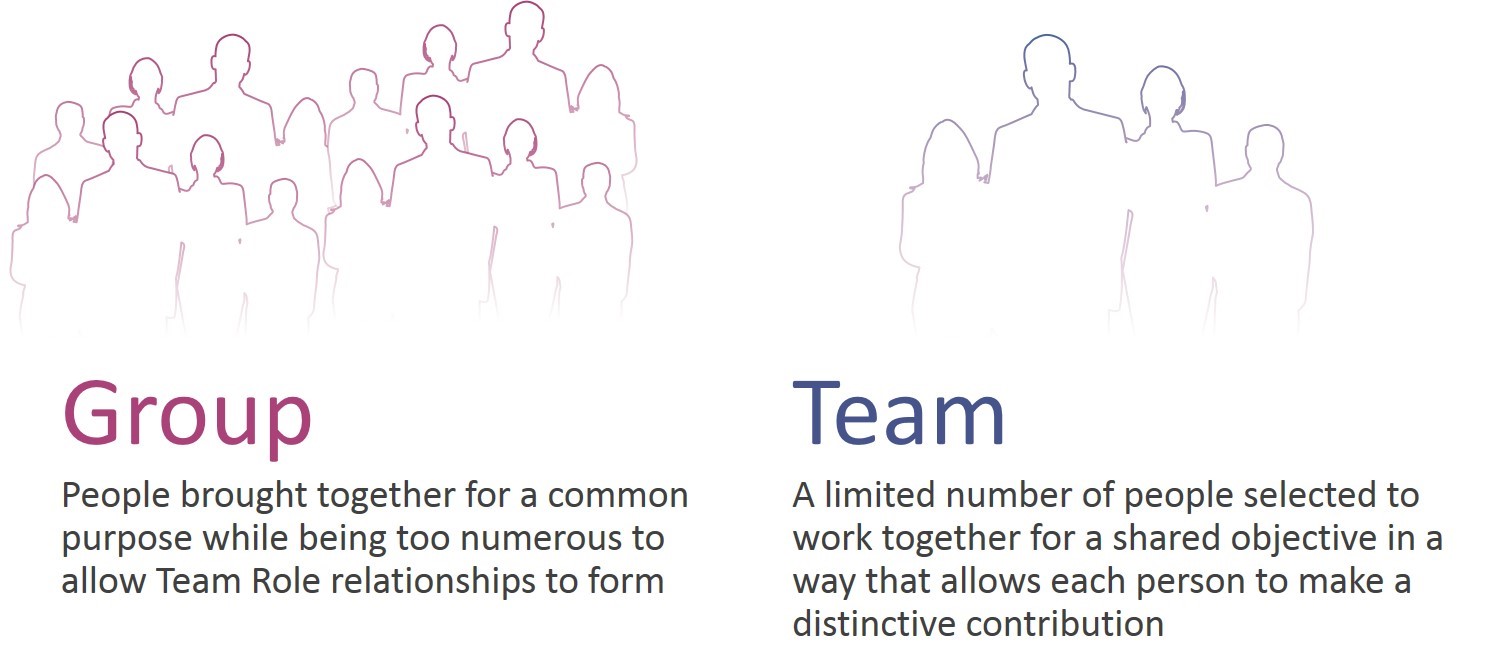
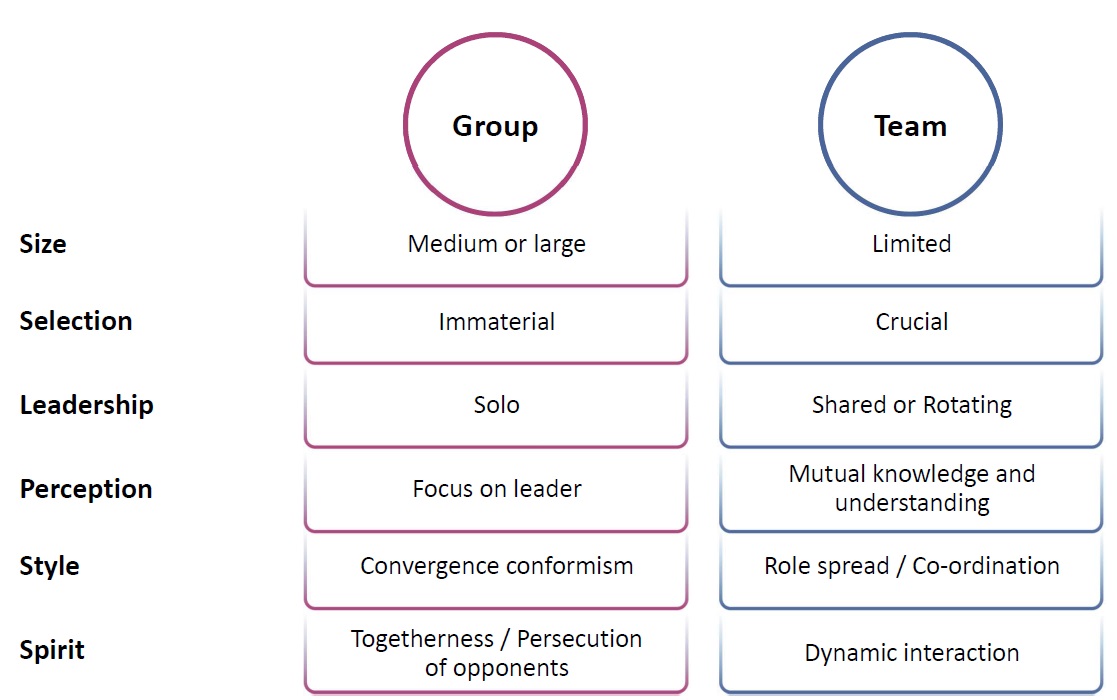
Differences between Teams and Groups
The larger the group the greater the tendency towards standardisation, to conformism, to follow the leader, to the cultivation of out-group feelings toward those that don't belong. The smaller team can afford to be more diverse and more tolerant and less compliant towards whoever is reckoned the most senior person.
Working in teams allows for shared or rotated leadership and promotes mutual understanding, since team members can get to know one another as more than just acquaintances.
With these characteristics in mind, how do you harness the power of teams to avoid groupthink? And how can Belbin help?
First, consider how your teams and groups approach decision-making.
In theory, when it comes to decision-making, collective is better than individual, owing to the potential for greater diversity. But therein lies the problem. Decision-making is in direct opposition to cohesion. Debating the merits of a particular course of action means exploring opposite points of view and drawing attention to areas of difference.
Remember Dr Belbin’s ideal team size, four? The even number is to ensure that no one person has the casting vote, so the team needs to arrive at decisions by arguing both sides and achieving consensus.
In Belbin terms, the ‘Thinking Roles’ are key here. Monitor Evaluators** for example, offer objectivity. They’re likely to take their time to arrive at a decision, but you can be assured that it will be well-considered. Plants** are creative, unorthodox and free-thinking. They’re not afraid to suggest change, which makes them a great antidote to conformist groups. Lastly, Specialists** can provide expert advice to inform decision-making on a particular topic.
The team’s receptivity – or lack thereof – to these contributions can help diagnose a collective culture that is heading towards groupthink. Is the team permanently closed off to the Plant’s ideas? Do they allow Monitor Evaluators their objective viewpoint, rush them, or accuse them of not understanding ‘how things are done round here’? Is Specialist knowledge dismissed or devalued to keep others in their comfort zone?
** To know more about the Team Roles mentioned here, download the document 'Team Role Summary Descriptions' from here
Second, recognise and cultivate behavioural diversity.
Personal convictions and values clearly have a part to play in avoiding groupthink, but the team needs behavioural diversity – distinct Team Role contributions and working styles which represent different approaches to a problem or task. We’re not claiming that Team Roles are the sole difference between ethical and unethical behaviour, but every group that goes off the rails has to obscure individual difference at some point. Belbin celebrates and promotes differences instead, and helps individuals find a way to work together.
The Team Role Circle, in the Belbin Team Report, offers an at-a-glance view of diversity within a team or group of up to 15 people. It’s possible to analyse the spread of Team Roles across Social**, Thinking** and Action** categories, to assess where gaps and overlaps may be leading the team or group towards homogeneity.
Third, reclaim the power of the individual.
Individuals who go against the grain are effective cures for groupthink (whistle-blowers are extreme examples of this), but individuals need to have the courage of their convictions.
By empowering individuals to discover and articulate their strengths and what sets them apart from others, you can help your teams and groups to reclaim individual responsibility, to get to know the different forces operating within the team, and to understand what a source of strength these differences can be.
The Belbin Team Report plots the highest-scoring individual for a given Belbin Team Role against the averages for that role. Where the gap is greatest, the individual in question may well face opposition for playing that role within a group culture.
This information is disseminated along with an obligation to leaders: to safeguard and nurture that opposing voice; to ensure that others understand the value of that contribution, and to put procedures in place to make certain that that view is heard.
Is it time to health-check your teams and groups?
What does your organization mean by ‘team’ and what more could be done to protect the term and distinguish teams from groups? How are you guarding against groupthink and cultivating behavioural diversity, whilst enabling people to work effectively together?
- The first step would be to ascertain the objective of the team - what is it here to achieve?
- Who should be involved? Here is the point where Belbin comes in, as you need to look for behavioural contributions and diversity, not just job titles and status.
- To put together a well balanced and diverse team, you need to understand individual behaviour.
- So, the next step is ask each potential member to complete a Belbin Individual Report.
- Then you can produce a Belbin Team Report which will allow you to uncover potential strengths, weaknesses, and explore behavioural diversity in your team.
- This information can then help you inform your team - how it works, and how tasks and responsibilities should be allocated.
Need some help? Give us a shout here
References
[1] Janis, I. L., Victims of Groupthink: a Psychological Study of Foreign-Policy Decisions and Fiascoes, 1972
[2] https://www.nytimes.com/2018/05/02/magazine/busted-leaders-boosted-economies.html
This article was originally published in the same title by Belbin Associates UK in www.belbin.com













